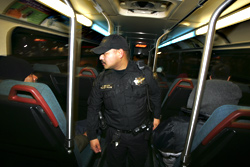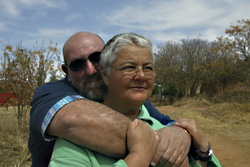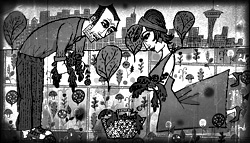Perhaps I’ve just been unlucky, but in less than a month, I’ve already accumulated more nasty encounters with threatening people on the bus in Seattle thanI did in the almost five years I spent in Washington, D.C., where I also used public transportation.
There was the guy last Saturday on the No. 15 who accosted one woman after another. I could smell the booze on him from 10 rows away. “Hey, pretty lady,” he leered. The woman pulled up her shoulders and avoided his gaze.
He moved over to another woman trying to hide behind a foldout city map. “You’re terrified, aren’t you?” he said. She shrugged and managed a nervous smile.
When the driver, who had been watching in the rearview mirror, asked where he was going, the man rushed the cockpit and screamed, “I’m not going anywhere!”
“You’re making me uncomfortable,” the driver said.
“Fuck your mother!” the man shouted. “You can’t throw me off!”
He eventually did get off when a man in the back stood up and threatened to kick his ass if he didn’t.
Then there was the guy screaming an unbroken string of profanities out of a back window to a woman on the street, forcing all the passengers to huddle at the front half of the bus. Another night, a guy cornered a stranger into a one-sided conversation loud enough for everyone to hear about the women he’d fucked, dudes he’d fought, times he’d been stabbed, and guns he used to carry. Between breaths, he gulped brown liquid from a 7-Up bottle.
In each instance, I expected the driver would call the police, who would appear at the next stop, board the bus, and take care of the problem. But that didn’t happen. Instead, we all—except for that brave man on the No. 15—just waited for the problem to disappear.
When there are minor infractions of the Metro passenger code of conduct (which states that passengers must, among other things, pay the right fare, respect other passengers’ privacy, not drink alcoholic beverages, and not harass anyone), drivers should continue on the route rather than inconvenience other riders by delaying service, according to Metro’s Web site. After all, people have places to go, and drivers have schedules to keep. Drivers are to be “peacekeepers, not enforcers.” But it also says, “Enforcement of the code of conduct is handled through a network of professionals that can be called upon by the bus driver, if and when needed.”
So where are these professionals, and why have I never seen them spring into action?
According to Metro Transit Police Sgt. Lonnie Arnold, there are a grand total of 44 officers—all deputies contracted from the King County Sheriff’s Office—tasked with policing all of Metro’s King County bus routes (1,100 Metro busses are in operation during any given weekday rush hour), in addition to shelters, transit stations, and park and rides. The Seattle Police Department also answers calls for service within city limits, but has no dedicated officers for Metro routes. Only about 36 officers actually patrol and answer calls for service; six of them are plainclothes and undercover.
In order to see exactly what it takes to get thrown off a bus in this town, I went along with these undercover transit cops one night earlier this month on an “emphasis”—a regular flooding of a problem route. This time, it was Route 358, running along Aurora Avenue, which consistently lands in Metro’s top five routes for number of “incidents” reported by drivers. During an “emphasis,” uniformed patrol officers follow the buses; bicycle officers and SWAT team members are posted at bus stops; and two teams of undercover officers are dispatched to play passenger.
The team I’m with consists of Roland Gervacio, 31, Woody Garrison, 51, and Donn Potteiger, 56. Armed with .40-caliber Glocks, pepper spray, Tasers, and a stack of comment cards for drivers to rate their police work, they pile into a van and head for the Aurora Transit Center at North 200th Street. Metro drivers file about 5,000 incident reports each year, and the most common complaints are driver assaults, harassment, drinking, vandalism, and nonspecific “rowdy” behavior. Technically, police can order passengers off the bus for being too smelly or for disturbing others, but Garrison says the prosecutor’s office has told them not to bother filing charges.
At 6:26 p.m., the van reaches the transit center, and Gervacio and Garrison jump out to catch a southbound 358. A few stops into the ride, a man wearing a Real Change identification card boards. As he walks by, his stench makes Gervacio flinch. “I don’t think that guy back there belongs on the bus,” Gervacio says. “He’s a known problem, and he always stinks, too. That’s how I recognized him.”
Gervacio confers with Garrison and then calls in to check the man’s background. Indeed, the man has been arrested twice for fighting and is barred from the bus until 2008. (When police issue a citation for a civil or criminal infraction on Metro property, they can also suspend riding privileges. In 2006, police issued 1,480 suspensions.)
Gervacio heads to the back of the bus. “Hey, you Grady Forest?” he asks.
“Yeah.”
“Aw, you’re not supposed to be on the bus, man.”
“No, I got a destination,” Forest protests. “I have to ride the bus to sell my papers to pay my rent.”
Gervacio shakes his head. “Sorry, man, but you’re on our list.”
Garrison and Gervacio remove Forest from the bus and place him under arrest, but the commanding officer tells them not to bother booking him. Driving him downtown would take too many officers out of the operation. Garrison uncuffs Forest and orders him to stay off the buses, which he knows is unlikely. “Short of locking someone up, how are you going to prevent them from using the only form of transportation available to them?” Garrison says.
At 7:15, on another 358, the driver recognizes Garrison and beckons him. “I’ve got two knuckleheads right behind me,” he whispers, indicating two men harassing a woman up front.
Garrison takes a seat beside the woman. “I think you might want to mind your own business,” he says to the men aftera moment.
“Oh yeah?” one man snarls. “How about we step off the bus?”
“That’s a great idea,” Garrison says, standing up and drawing his badge. “Let’s step off the bus.”
The man’s eyes double in size, and he instantly deflates. “Aw, shit,” he mutters.
The passengers, shocked at first to see policemen on the bus, appear ready to burst into cheers as Garrison removes the man. On the street, Garrison runs the man’s identification. He turns out to be a convicted sex offender recently out of prison.
“How much have you had to drink tonight?” Garrison asks.
“S— , I mean, five beers.”
“Well, thanks for being honest,” Garrison says. “Most people usually say one or two. Look, you were being obnoxious on that bus. You’ve got to leave our customers alone. If someone wants to talk, they’ll let you know. It’s all about social skills. Now stay off the bus for the rest of the night.”
On the way to catch another bus, I ask the team how they’re supposed to police such a large jurisdiction with so few officers. The short answer: They can’t. “Crime is huge for Metro,” Gervacio says. “Even if we doubled or tripled the force, there still wouldn’t be enough.”
But Metro’s primary goal is keeping the buses moving and on time, not chasing crooks, and some believe that more police would mean more delays. Gervacio says most drivers will put up with all kinds of nuisances just so they can finish their route. But it doesn’t look all that time-consuming to me: Each time the undercover team removes a troublemaker, they simply ring the bell, whisk him away at the next stop, and the bus goes along its way. It takes longer to board a wheelchair-bound rider.
At 9:47 p.m., after removing a drinker, the team catches one last bus going northbound. Despite being standing room only, it yields no arrests, and the cops head home. Back at the base, the team disperses, and I ask Garrison for directions to the nearest bus stop. He still has paperwork to finish before he can punch out, but he insists on driving me home. “Don’t you know what kind of people ride the bus this time of night?” he says.








